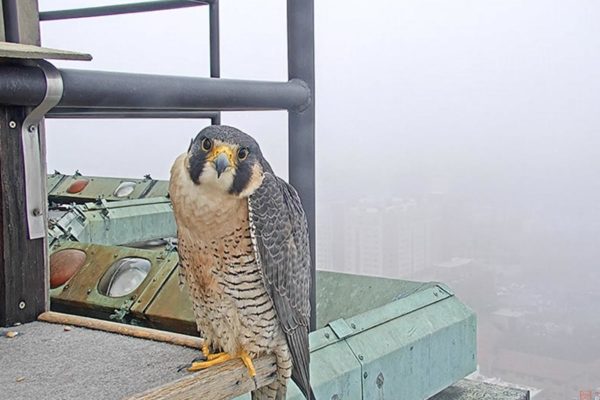AUSTIN, Texas — The city’s only known year-round resident peregrine falcon is getting a global audience. The bird, nicknamed Tower Girl, lives atop the University of Texas at Austin Tower and has a handful of avid fans who love to watch one of the world’s fastest animals dive through the skies above campus. And now, UT’s Biodiversity Center has launched a live-streaming webcam so that viewers around the world can observe everyone’s favorite local raptor in real time.
“I’m excited to see the camera up and running,” said Tim Keitt, a professor of integrative biology who teaches classes on birds and field courses in bird-watching and identification. “This is another opportunity to get students and the public excited about birds and nature.”
Birders estimate that Tower Girl has lived on the UT Tower for about eight years. The camera comes at a particularly exciting time because she was observed displaying mating behaviors with a male peregrine for the first time in January. The new camera provides an opportunity for scientists to gain important information about her behavior, mating habits, diet and nesting success remotely without disturbing the bird or driving her off from the location.
If Tower Girl lays eggs, viewers will be able to observe the eggs, including when and whether they hatch. Austin is considered the edge of the peregrine breeding range, so any hatching eggs atop the UT Tower would expand the known breeding range of the species.
UT students have been learning from Tower Girl for several years. She is often the first subject students in classes such as Biology of Birds observe, and they practice their field work and observational skills on her. Now the public will get an up-close view, as well, and Keitt and others hope that more people will be inspired to protect local wildlife and ecosystems.
“Nature that is not observed and appreciated by people becomes endangered through neglect,” Keitt said. “People’s personal experience observing and interacting with biodiversity is how we come to value biodiversity and prioritize its study and conservation.”
The peregrine falcon is thought to be able to reach 200 miles per hour when it dives. Its diet consists mostly of birds such as doves, grackles and pigeons. Peregrines are considered an endangered species success story.
“Peregrine falcons were once common nesters in urban environments and then became endangered in the 1950s, ’60s and ’70s,” said David Hillis, director of UT’s Biodiversity Center. “Protection of the species, efforts to put up breeding boxes and a ban on the chemical DDT, which thinned their egg shells, led to recovery of the species since then.”
Peregrine falcons were removed from the federal endangered species list in 1999, though their Texas status remains endangered.
Placing the camera on the Tower was not an easy feat. The project was first proposed last summer. Workers faced challenges in setting up live web-streaming and supplying power to a camera on a building built in 1932. They had to deal with bad weather and could work only when the falcon was not in her nest so as not to scare her away.
UT scientists hope the camera will inspire Central Texans and people around the world to pay attention to the rich variety that the natural world has to offer.
“Don’t forget to go outside and identify some species after watching the webcam,” Keitt said. “The idea of biodiversity is really about how we interact with nature. We hope the Biodiversity Center will help people to reconnect with the diversity of life all around us.”
Log on to the Biodiversity Center website to try to catch a glimpse of Tower Girl.
Full link: https://biodiversity.utexas.edu/resources/falcon-cam
Short link for print: http://txsci.net/falconcam
High-resolution photos and video are available for use with attribution: https://utexas.box.com/v/FalconCam




